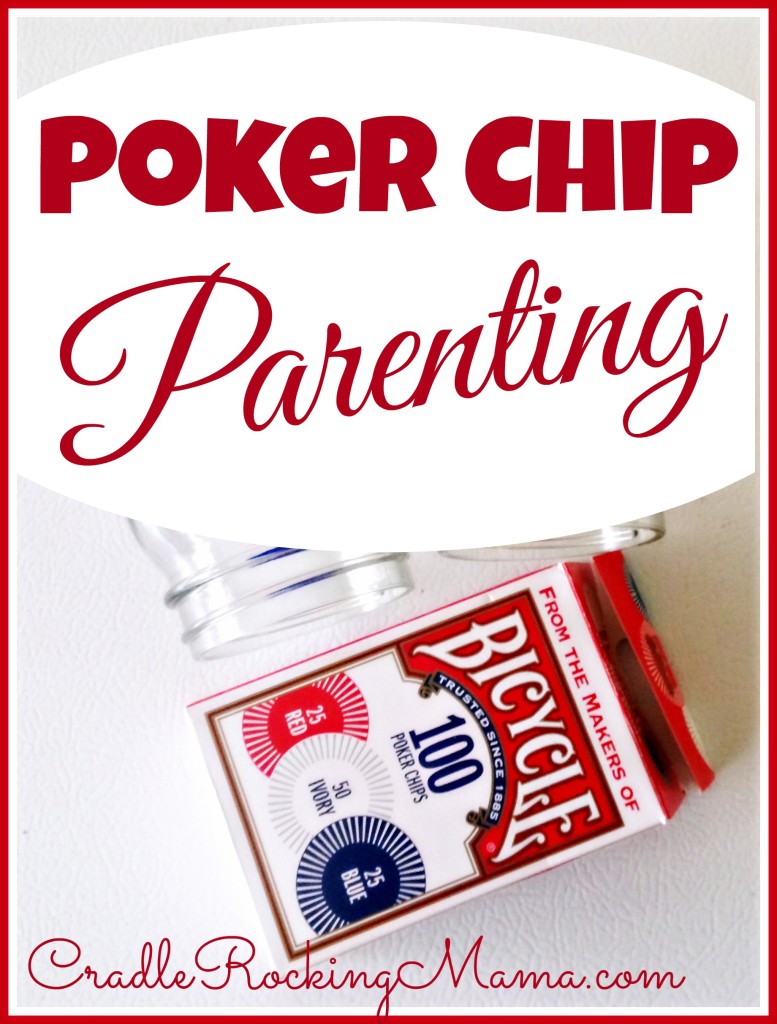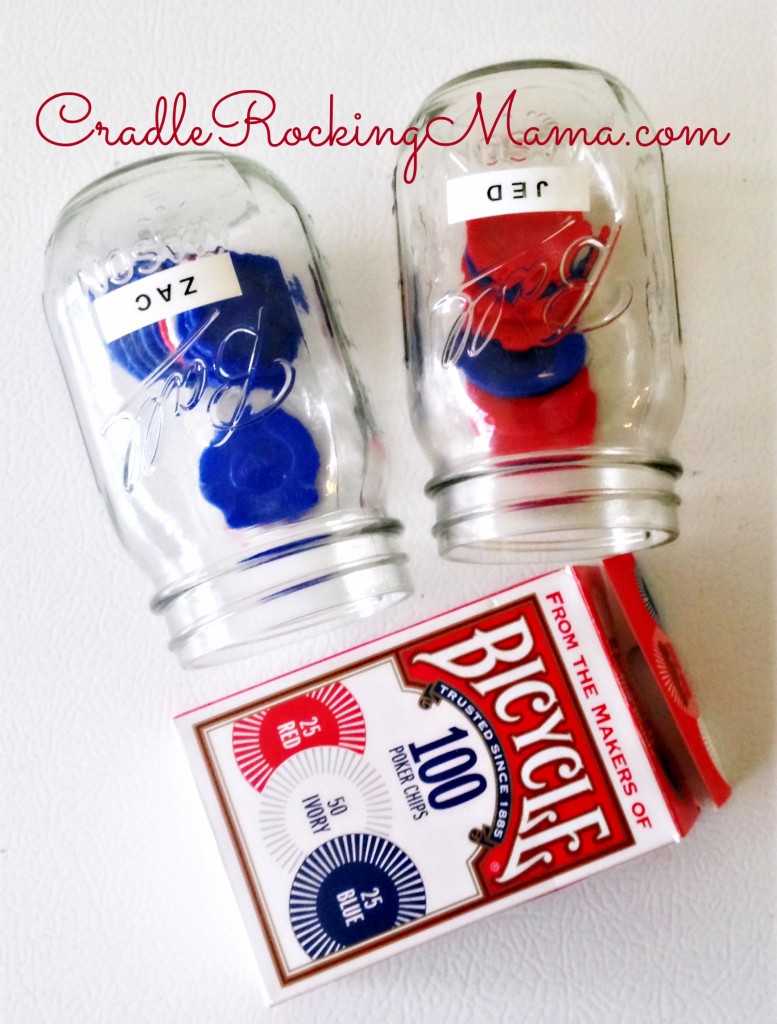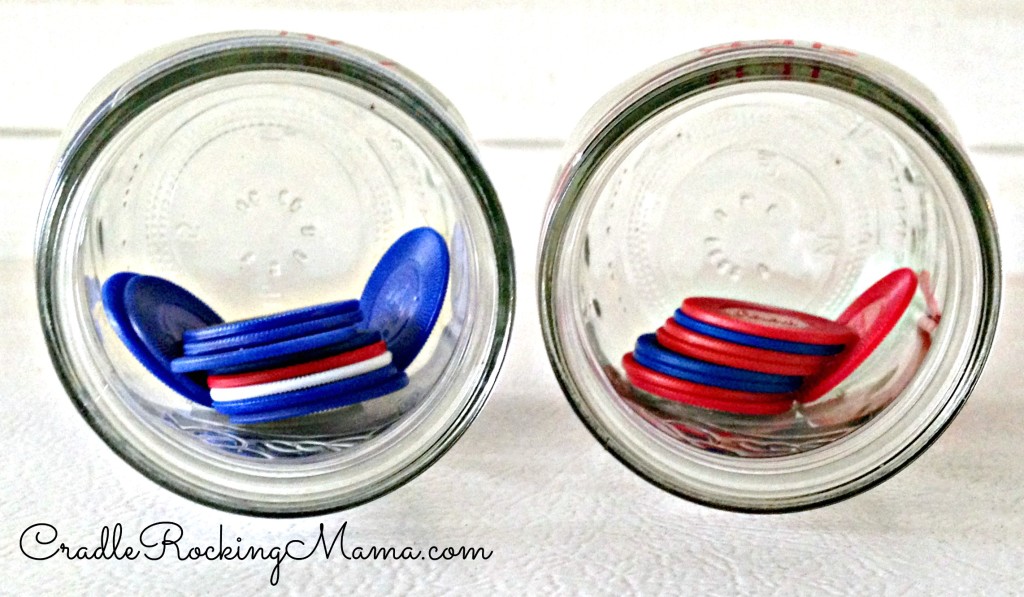***Updated 9/26/16 See Bottom of Post***
Back in February I flew with an amazing Flight Attendant. The two days I spent with her were refreshing, largely due to her obvious joy in her children and grandchildren.
Her three kids are grown and excelling in everything they do. They’re a close knit family; she even had a broken nail from playing basketball with her grandson. Every story she shared made me impressed and inspired.
On our last flight together, I expressed my admiration for her mothering skills and asked what she had done when her kids were little to encourage them to mind her, be responsible, and do chores – with a good attitude.
Honestly, I expected some sort of “oh, I don’t know…they’re just really good kids” sort of answer.
Again, though, she surprised and enchanted me.
She sat up a little straighter and got a gleam in her eye as she explained the system she used for her kids that helped her teach them to strive for excellence.
And the whole thing revolved around poker chips.
To say I was excited would be an understatement! Darrel and I have been trying different combinations of chore charts, rewards, and payments for Jed, and while none have been complete failures, none have worked as well as we’d hoped, either.
Part of the problem is my work schedule. Being gone so often, the kids stay with my parents quite a bit. They expect the kids to help with different chores than we expect, and the payment method was always too complicated to keep straight between houses. Consequently, the adults kept dropping the ball.
Since consistency is key to so much of child-raising, this was proving to be the biggest problem in our efforts to guide Jed in respect to chores and demeanor.
The system my dear co-worker described to me is INCREDIBLY simple, and therefore would be easy to implement regardless of who was in charge that day or what house the kids were at.
Darrel was intrigued, as well, so we bought some cheap poker chips and gave it a try.
We’ve been using this system for two months now, and it works beautifully!
Here is all you need to do this for your kids:
- Blue, red, and white poker chips
- Small pint sized mason jars (or equivalent) to store the earned chips
- Something the kids can “buy” with their earned chips
I’ve mentioned before that my kids watch entirely too much TV, thanks to the many hours I have to spend in the kitchen.
They’re finally getting old enough that they can help me in the kitchen and do simple crafts without much supervision, which is lovely. It also means I can rely less on the TV to entertain them.
Unfortunately, they’ve grown accustomed to watching their favorite movies and shows.
So the thing our kids can “buy” with their earned chips is screen time, whether a TV show, playing a computer game, or playing an app on one of our phones.
I strongly suggest using screen time as the motivator for your kids. It automatically reduces the amount of screen time the kids can get, since they can only earn a maximum amount of screen time per day.
However, anything your kiddos LOVE but never seem to get enough of would probably work just as well.
Now that you’ve got all your supplies, here is how it works:
The kids earn one chip per day based on their behavior. For us that means doing expected chores willingly and without reminding or nagging, using self-control by playing nicely with siblings, not throwing tantrums, using manners when speaking to people, and having a good spirit, such as showing a willingness to help, respect in disagreements, and General Pleasantness. (More about this later.)
They must use their chips to buy whatever privilege is being used as currency in the home (screen time for us).
– Blue chips are earned by excellent behavior. No child is perfect, of course, but a blue chip day is one in which there were no disciplinary actions taken. Gentle reminding and immediate positive responses are examples of the worst a blue chip day will see.
You can allocate your own value to each chip, of course. For us, a blue chip is worth 90 minutes of screen time. That’s enough for one average kids movie, or 4 Netflix TV episodes (no commercials).
– Red chips are earned for fairly good, but somewhat naughty behavior. A red chip day might involve one or two time outs, or having to do the “if you don’t straighten up right this minute we are leaving the park and not coming back” threat, or having to repeat yourself several times to get a chore done. Overall the child behaved well, but there were some moments of ‘not good’ thrown in.
A red chip is worth 30 minutes of screen time.
– A white chip is earned on those days when you question your decision to become a parent. The kiddos misbehave all day, fight amongst themselves, show no cooperation, respect, or pleasantness at all. We all hate white chip days, am I right?
White chips earn nothing. Nada. Not one tiny second of screen time.
At the end of each day, the child is awarded the appropriate chip. I usually use that moment to explain why they got the chip they did, and I’m usually pretty detailed.
“Jed,” I might say, “you earned a blue chip today! I really appreciated how you came and unloaded the dishwasher the first time I asked you to, and you played very nicely with Zac all day long.”
Now, here’s where it gets interesting. I said I’d talk more about the behavior expected to earn their chips, because you were probably thinking what I thought when I first heard this. “Gee, this sounds great, but very vague. How can the kids do what is expected of them when the criteria is so broad?” Right?
Let me tell you, our kids are much more observant and aware than we give them credit for! Both my kids were able to catch on within a day or two of using this system, to the point where, if they earn a red chip, I can say, “Sweetie, you got a red chip today. Can you think of the reason why you got a red chip instead of a blue chip?”…and they can generally tell me what behavior they did that was out of line – AND what they might do next time to correct it!
Sometimes I even ask Jed which color chip HE thinks he has earned that day, to test his honesty and awareness.
Funnily enough, he’s usually harder on himself than I am! He regularly assigns himself a red chip on days when I’m about to award a blue chip, or a white chip on red chip days. Sometimes I give him the chip I planned to, but sometimes he reminds me of things that happened in the morning that I had forgotten all about, and I give him the chip he thinks he earned.
While it is important to remember to consistently award chips for good behavior, it’s also just as important to remember to TAKE chips for their treats! I’ve noticed that when Jed’s jar gets more “full” of chips to spend (aka the parents are dropping the ball), he seems to earn a lot more red and white chips.
When he realizes he’s about to lose all screen time if he runs out, he suddenly makes sure to earn blue chips!
Stockpiling chips is not effective for some kids, apparently.
Now, is this going to make our children become perfect angels overnight? No. Nothing will do that!
But for my kids, it managed to finally get the point across that they are expected to – consistently – behave well. Giving them tangible evidence of how well they behaved and how they are expected to behave has helped enormously in making my boys more evenly “good” throughout the weeks.
I’m most looking forward to the day my genius co-worker told me about. I asked her “When did you stop using the chips?” She said that eventually, gradually, her kids just behaved well 90% of the time all on their own and the chip system faded out of use.
Having kids who behave well all on their own? Priceless.
Poker chips are cheap; what they’re gaining my family is worth a million times their cost.
Have you also struggled with a suitable chore/reward chart for your kids? Do you think this method might work for you?
*****UPDATE 9/26/16*****
We’ve been using this system for a long time now, and it still works. However, over time we realized there were a bit too many “rewards” here and not quite enough “consequences”. So we’ve made some adjustments to the system:
Blue chip=40 minutes of screen time OR $1.00
Red chip=20 minutes of screen time OR $.50
This allows the kids less screen time than before, now that they’ve gotten used to a limited amount, and gives them the option of choosing to buy themselves a toy instead.
We also now make them “redeem” any white chips with red chips. So, if they have ‘earned’ a white chip, they must pay us a red chip to get it out of their jar before they can use their chips for screen time or money. That alone has greatly reduced laziness and bad behavior!
We have also found it effective, at times, to issue a white chip independently of the days reward for unacceptable behavior that we need to curb. If they don’t seem to understand that we are serious about whatever we are telling them to stop doing, then informing them that from now on, they will get a white chip for every time they do it works VERY well at stemming that behavior! Of course, if they earn a white chip for a certain bad behavior, they’re likely to only earn a red chip for the day. So, double whammy.
These changes have been great for teaching consequences and thinking through behavior before they do it, and it is still simple to utilize.
Whether you use this program as originally presented, or with the additional adjustments, it’s still the best thing I’ve found to use!














Pingback: Aren’t 4 Year Olds Supposed to Have a Bedtime? - Cradle Rocking Mama
Pingback: How I beat my internet addiction - 1nfinite zer0 - dj FORAGE
Pingback: Make A "Jeopardy" Style Quiz Board -